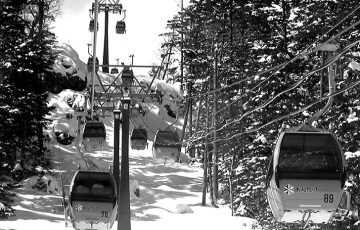Japanese summers, south of the Tohoku and below five hundred metres, are notoriously hot and tropically muggy. In the heat islands of the major cities, things get particularly steamy: August temperatures in Tokyo are generally over thirty degrees Celsius; nights rarely dip below the mid twenties. Osaka and Kyoto are typically a few degrees warmer, pushing the temperatures over that fine line between slightly-too-hot and much-too-hot.
What better way, then, to enjoy Japanese summer than to escape the cities? The high mountains are refreshingly cool in contrast to July and August temperatures closer to sea level, there are plenty of decent beaches within easy reach of the major cities—some of them even, misleadingly, officially part of metropolitan Tokyo—and there are scuba diving outfits with English-speaking instructors from Hokkaido to Okinawa, and both white water and flat water kayaking for those who prefer to stay above the surface, at least most of the time.
Above the Clouds
With peaks reaching up to three thousand metres and above, the Japan Alps are a cool escape from the lowlands, and easily accessed from both the Kansai and Kanto regions. Snow-clad much of the year, the Alps are only readily accessible to amateur climbers in the summer months, out of the danger of the avalanche season.
Kamikochi, a cluster of hotels, campgrounds, and visitor centre is a good place to start. From there you can take day hikes or trek across the mountains to Hotaka. You’ll need at least three days to get to the higher peaks and back, but scaling Japan’s third highest mountain, Mount Oku-hotaka, is exhilarating despite its popularity, as is the rather precarious ladder-and-chain ascent of the distinctively pointed Mount Yari, particularly at sunrise. Off the main tracks things are quieter, and the alternative route between the hut at Karasawa and Mount Yari–which features a sheer cliff and a long drop–is hair-raising enough to satisfy the thrills of all but the most experienced hikers.
One of the things that makes the Japan Alps more accessible than many new world ranges are the excellent mountain huts, or yama-goya, which provide dorm-style futons and meals for about seven or eight thousand yen. You can also camp cheaply in the often rocky campgrounds by the huts.
Don’t be fooled by the crowds of silver-haired hikers coming down from the peaks, these are serious mountains. While you won’t need oxygen you will need proper hiking boots, maps, and wet and warm weather gear. Lonely Planet’s English-language Hiking in Japan guide is a good place to begin planning, and has plenty of information on Japan’s other ranges and peaks.
The Edge of the Sea
An island country with plenty of shoreline, Japan has surprisingly few good beaches, compared to, say, Australia, and far more people per grain of sand. While Okinawa is the poster child for Japanese beaches, there is plenty of oft-forgotten sandy coast closer to home. While Enoshima and Kamakura are not spectacular, they are perfect–though popular–for day-trippers, but the real gems are to be found farther afield–though, intriguingly, still in Tokyo.
The Izu Islands stretch south from Tokyo bay towards Guam, and have the slow, sun-drenched feel of a hidden paradise. An overnight ferry ride will take you to the largest and closest of them, Izu Oshima, crowned by the volcanic Mount Mihara, which last erupted–stunningly–in 1986. The sand on some of the beaches, is, consequently and somewhat shockingly, black. Further into the chain, Nii-jima’s beaches are the more common beige, but the water is warm, clean, and blue, and there are sheltered coves on one side of the island and a long beach with occasional decent surf on the other, about twenty minutes away by bicycle. Nearby Shikine-jima is better known for its hot springs than beaches, but there’s good snorkelling at Tomari Beach where the water is clear. Most famous is Mikura-jima, where you can swim and snorkel with the wild dolphins, which is said to be breathtaking.
All the inhabited Izu Islands have minshuku, ryokan, and hotel accommodation, as well as often-free though basic campsites if you have your own tent. While some of the islands have airports, others can only be reached by ferry.
Beneath the Waves
Japan’s scuba diving, though not always world-class, is reasonable and easily accessible. There are outfitters on the Izu Peninsula, which tends to get a bit over-crowded during the summer, the Izu Islands, and in Okinawa, many of whom are happy to deal with English enquiries.
Just north of the Tropic of Cancer, the oceans surrounding Okinawa are both warm and clear. Okinawan seas are home to over four hundred species of coral which, with the diversity of fish species, is ideal for snorkelling and scuba diving. Mysterious underwater standing stones, off the coast of Yonagumi-jima, are believed by some to be ruined pyramids of an ancient civilisation. More rational arguments maintain that the “structures” are natural rock formations, but they are fascinating nonetheless and can only be explored by divers.
Closer to the capital, the volcanic Izu Islands are home to some of Japan’s best dive sites. With lava arches and other aquatic volcanic formations to explore, as well as an interesting variety of soft corals, marine plants, and fish species, the islands are also a good destination if you prefer to stay above the surface, and offer an excellent compromise if there are two or more of you, and only one diver.
On the Water
Japan’s convoluted coastlines are a fantastic destination for sea kayakers of all levels and abilities. From the white sands and green mangroves of Okinawa, to the rugged shorelines as far north as Hokkaido, Japan’s coast provides stunning views and countless coves to be explored by kayak.
The Seto Inland Sea, more convenient to Kansai than Kanto, is a wonderful place to explore by sea kayak. The area is dotted with inhabited islands and the generally calm waters are protected by a marine park – though you’ll want to stay well away from the famous whirlpool, which can be enormous when the tides are right. Closer to Kanto, there are kayaking schools around the Izu Peninsula, where you can explore the rocky coastlines (rather than the crowded beaches) within sight of Mount Fuji.
Further afield, Hokkaido has the added attraction of being relatively cool during the summer months. Though it can seem a long way from home, there are excellent ferry services and overnight trains, as well as flights, to Japan’s most northern main island.
Making a Splash
Inland, white rivers–though more often than not tamed somewhere along their course by a dam–rush down from craggy peaks from Shikoku to Hokkaido. The summer heat makes white water sports particularly attractive, and a good rainy season will keep the rivers full, proving that all that damp is in fact useful for something.
The Kanto Region’s Tone River, Japan’s biggest, is also one of the best for white water, with grade four rapids making for exciting paddling. Nearer to Kansai, Shikoku’s Yoshino River boasts continuous stretches of grade 3 and 4 rapids running through a series of spectacular gorges. Outfitters are generally set up to rent gear to experienced paddlers as well as offer training if you’re still working on your skills. Rapids also bring out rafters, and you can try a day or half day of rafting on many of Japan’s white rivers through the same companies which will set you up with kayaks and paddles.
Resources
Adventure sports of all kinds attract travellers everywhere, and a good many of Japan’s outfitters have either lived overseas or hail from abroad originally. Reasonably up-to-date information on outfitters can be found in guidebooks, up-to-the-minute details and recommendations can be found on the internet.
Story by Manami Okazaki
From J SELECT Magazine, July 2009















Recent Comments